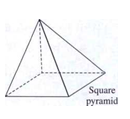Define Euler's relation between the number of faces, number of edges and number of vertices for various 3-dimensional figures.
To define Euler's relation between the number of faces, edges, and vertices for various three-dimensional figures, we can follow these steps:
1. Understanding the Terms:
- In a three-dimensional figure, we have:
- Faces (f): The flat surfaces that make up the shape.
- Edges (e): The line segments where two faces meet.
- Vertices (v): The points where edges meet.
2. Euler's Formula:
- Euler's relation for three-dimensional figures can be expressed as:
f−e+v=2
- This means that if you take the number of faces, subtract the number of edges, and add the number of vertices, the result will always equal 2 for convex polyhedra.
3. Examples:
- Cube:
- Faces (f) = 6
- Edges (e) = 12
- Vertices (v) = 8
- Check: 6−12+8=2 (holds true)
- Tetrahedron:
- Faces (f) = 4
- Edges (e) = 6
- Vertices (v) = 4
- Check: 4−6+4=2 (holds true)
- Octahedron:
- Faces (f) = 8
- Edges (e) = 12
- Vertices (v) = 6
- Check: 8−12+6=2 (holds true)
4. Conclusion:
- Euler's relation is a fundamental property of convex polyhedra and helps in understanding the relationship between the geometric properties of three-dimensional figures.
- In a three-dimensional figure, we have:
- Faces (f): The flat surfaces that make up the shape.
- Edges (e): The line segments where two faces meet.
- Vertices (v): The points where edges meet.
- Euler's relation for three-dimensional figures can be expressed as:
f−e+v=2
- This means that if you take the number of faces, subtract the number of edges, and add the number of vertices, the result will always equal 2 for convex polyhedra.
- Cube:
- Faces (f) = 6
- Edges (e) = 12
- Vertices (v) = 8
- Check: 6−12+8=2 (holds true)
- Tetrahedron:
- Faces (f) = 4
- Edges (e) = 6
- Vertices (v) = 4
- Check: 4−6+4=2 (holds true)
- Octahedron:
- Faces (f) = 8
- Edges (e) = 12
- Vertices (v) = 6
- Check: 8−12+6=2 (holds true)
- Euler's relation is a fundamental property of convex polyhedra and helps in understanding the relationship between the geometric properties of three-dimensional figures.
Topper's Solved these Questions
Similar Questions
Knowledge Check
The number of faces and edges a tetrahedron respectively has
A6, 6B4, 6C4, 4D5, 5If x, y and z represent the number of faces, number of vertices and number of edges respectively of a polyhedron, then which of the following is true ?
Ay−2=z+xBx−2=z−yCx+2=z−yDz−2=x−y
The number of edges in the given figure is

View SolutionWhat is the relation between mass and number of moles of the gas ?
View SolutionThe number of faces in the given figure is

View SolutionThe number of faces in the given figure is

View SolutionThe ratio of the number of sides of a square to the number of edges of a cube is
View SolutionWrite the number of vertices, edges and faces of a pentagonal prism ?
View Solution

